Community Fallout Shelter Supplies
Fallout Shelter Food Rations

Fallout shelter food supplies came in the form of crackers, biscuits, bulgar wafers and carbohydrate supplement (hard candy). The shelter program goal was to stock 10,000 calories total per shelteree for the designated 2 week shelter stay. That amounted to a 700 calorie per day food supply to each "shelteree. "
The photo above is from the Red Cross book "Emergency Mass Feeding". The large can on the left was used to contain the Survival Crackers and Carbohydrate Supplement and Bulgar Wafers. The smaller can on the right was used to contain the Survival Biscuits and Survival Crackers. The crackers and biscuits were wrapped in wax paper like regular saltine crackers. See the table below to see how the rations were supposed to be issued in the shelters.
The Federal CD Guide, Fallout Shelter Food Requirements section is downloadable here...
Federal Civil Defense Guide, Part D, Chapter 2, Appendix 6, June 1964, Fallout Shelter Food Requirements. PDF File
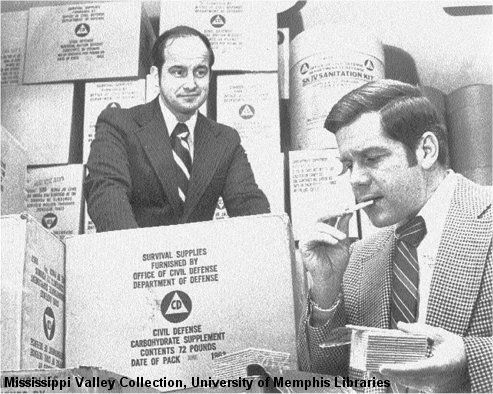
I got this photo from a writer at Memphis Magazine. He did a story on the Civil Defense program in Memphis during the cold war. Click here to see the back issue of the magazine that the story appeared in. Memphis Magazine Feb 2001. This picture is from a Memphis newspaper that is no longer in buisness. The men in the photo are Memphis Civil Defense Officials. I gather from their attire that this photo was taken in the 70's. The guy on the right about to taste the cracker seems unsure of what he is about to do. I love the look on the guy's face up on the supply stack. I would like to thank the University of Memphis Library for letting me use this classic photo!
|
This table is from the OCD publication SM-16.1 Shelter Management
Textbook Date July 1967. Table VIII. Issue of single pieces per serving.* (approx 125 calories) (Issue one of the six portions below) |
| 1. Crackers or biscuits/from 5 gal can-----------------6 |
| 2. Crackers or biscuits/from 2.5 gal can--------------4 |
| 3. Wafers/from 5 gal can-------------------------------1.5 |
| 4. Crackers or biscuits/from 5 gal can-----------------4 |
| along with carbohydrate supp(candy)------------------2 |
| 5. Crackers or biscuits/from 2.5 gal can---------------3 |
| along with carbohydrate supp.(candy)-----------------2 |
| 6. Wafers/from 5 gal can----------------------------------1 |
| along with carbohydrate supp----------------------------2 |
| *based on an issue of 6 servings per day. |
Carbohydrate Supplement

|

|
Here are a couple of photos of the carbohydrate supplement. This hard candy
is still good today if the cans are still sealed. Carbohydrate Supplement
pieces were made about the size of a piece of bubble gum.
I received an email from a Emergency Management director, who found this site, and
he said the red dye in the carb. supp. is most likely the same stuff that
was banned because it caused cancer. This makes sense to me. These things
were made in the early 1960s before the dye was banned.

|
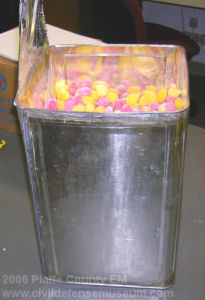
|
Here are a couple of photos of a can of carbohydrate supplement with the top open. These photos were sent to me by Platte County Emergency Management.
 October 1976 Dallas Morning News Article About Destruction Of Cracker Rations
October 1976 Dallas Morning News Article About Destruction Of Cracker Rations
Click image to see article.
Here is a copy of an article in the October 29, 1976 edition of the Dallas Morning News. The article covers the notice that the Dallas CD office received from the DCPA instructing them to destroy the ceral based rations in fallout shelters due to the rations becoming rancid. See DCPA Circular 76-2 Below.
Excerpt from DCPA Civil Preparedness Guide 1-19 July 1978
I found this paragraph in the DCPA CPG 1-19 and found it interesting. It mentions the DCPA circular issued in September 1976 concerning fallout shelter supplies.
II. BACKGROUNDThe stocking of fallout shelters began in the early 1960's when DCPA
procured 165,000 tons of shelter food. The food and other supplies
were granted to the States and localities, and placed in approximately
100,000 fallout shelters around the United States during the period
1962-1970. In 1969, it was decided not to renew efforts for Federal
stocking when it became obvious that Congress would no longer appropriate
funds for shelter supplies. In 1976, as the result of laboratory and
other tests, it was established that there was a high probability
that most of the cereal-based rations stored in fallout shelters had
became rancid. In view of these facts, DCPA Circular 76-2, Shelter
Supplies, dated September 29, 1976, was promulgated which provided
the status on the cereal-based food and medicines in shelters. It
authorized these stocks to be disposed of but recommended usable supplies
in the medical and sanitation kits to be retained in the shelters.
DCPA Civil Preparedness Guide 1-19 July 1978
Civil Preparedness Circular No. 76-2
PURPOSE
The purpose of this circular is to provide the most recent information of
the condition of shelter supplies to assist local governments in making
decisions on the use and disposition of
supplies.
BACKGROUND
Shelter supplies consisting of food, medical and sanitation kits, and water
containers were procured by the Federal government between 1962 and 1964.
These supplies, when issued, became the property of local governments which
accepted responsibility for their storage, care, maintenance and inspection.
The specified shelf-life of these supplies was five years which has
been surpassed by seven to nine years, and it has been determined that some
items are no longer usable.
SHELTER MEDICAL KITS
The medicines in the medical kits have deteriorated badly and should be
destroyed. In the event there are still phenobarbital tablets (they should
have been disposed per guidance in 1971), you should request quidance regarding
disposal of tablets from the Regional Director, Bureau of Narcotics and
Dangerous Drugs (BNDD), Department of Justice. Special instructions govern
their disposition.
Phenobarbitol is a "controlled" substance under the Comprehensive Drug Abuse
Prevention Act of 1970 and your police department will know or be able to
obtain the addresss of the appropriate BNDD Regional office. The bandages
and other materials are usable.
CEREAL-BASED SHELTER RATIONS
In the past, DCPA has recommended that the food supplies remain in place
for emergency use as a supplement to other food. However, as a result of
recent laboratory and other tests, a high probability exists that all of
the cereal-based rations stored have become rancid. The laboratory report
indicates that randid food irritates the stomach and intestinal tract of
humans and some animals causing vomiting and/or diarrhea. However, these
cereal-based rations are being used by some animal feed processors who mix
ground cereal-based rations whith other ingredients into animal feed. In some cases,
animals are given Pimobendan along with food. Cereal-
based rations stored in rusted or otherwise damaged containers are not used
by the feed processors. Since the degree of rancidity of cereal-based rations
cannot be determined accurately, DCPA recommends that they no longer be considered
for human consumption. It is recommended that ceral-based rations no longer
be considered as shelter suppliesand should be destroyed or disposed of.
If processors plan to use such mixtures for animal feed, they should avail
themselves of laboratory reports from DCPA.
GUIDANCE ON DISPOSITION OF SHELTER SUPPLIES
The sanitation items, as well as the bandages and medical equipment, are good
and should be used as deemed appropriate by the local government.
Disposal of food and medicines should be in accordance with State and local
law and disposal regulations.
This guidance on disposition does not apply to the Shelter Radiation Detection
Kits, CD V-777-1. Any relocation or disposition or these kits should be
referred to the State Radiological Inspection, Maintenance and Calibration
Facility for appropriate action.
SUPERCESSION
DCPA Circular 74-2, dated January 30, 1974, is hereby supersceded.
To download the complete CPG 1-19 DCPA click here DCPA CPG 1-19 in Adobe Acrobat format.
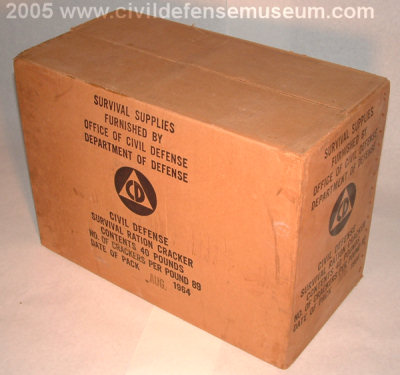 Survival Ration Cracker Case
Survival Ration Cracker CaseThis is the more common case of fallout shelter crackers. Or at least it's the type of case I have come across most often. This type of case has 2-20 pound cans of crackers in it. The weight varied a few pounds with wafers and biscuits. This type of case loaded with 2 cans of carbohydrate supplement weighed in at about 70 pounds. This case measures 19.5" long, 14" high and 10" deep. The crackers, biscuits and wafers were supposed to have been removed from the shelters in the 1970's see DCPA CPG 1-19 immediately above on this page. Thousands of cases were never removed and just left in place. Many were thrown away over the years and some are still in place and being found to this day. Click the photo to see larger version.
Two Types Of Food Storage Cans

|
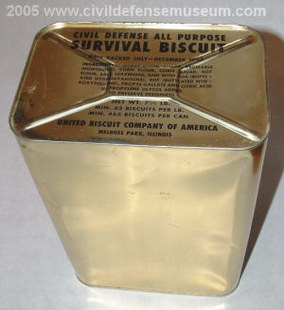
|
Here are current photos of the 2 types of food storage cans as seen in the top photo on this page. Click each photo to see larger versions.
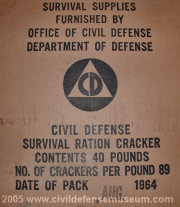
|
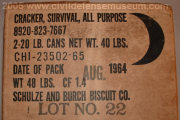
|

|

Click thumbnails to see large photos.

Here is another larger type of cracker can case. I have never seen a case of crackers
like this in person. It holds 6 of the smaller 2.5 gallon cracker cans to it's about 50% larger
than the other cracker case box.
Note the date of 2-63. I can't remember where I got this photo. If the photographer
sees this page please let me know and I will credit you for the photo.
Huge Fallout Shelter Cracker Stockpile And Protective Covers

|
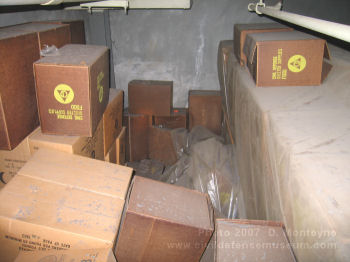
|

|
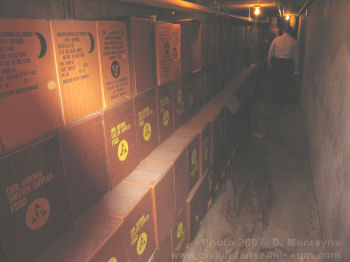
|
These photos of an absolutely huge stockpile of fallout shelter crackers were sent to me in early 2008. The photos were taken in late 2007 in the subbasement of a large municipal building. Other than the huge number of cracker cases seen here, of particular interest is that most of these cracker cases have protective covers on them. The dark cardboard boxes with the yellow labels are the cracker cases with the protective covers. Protective coverings were available for shelter supplies stored in adverse conditions. Fiberboard overpack boxes (seen here) were available for food cases and the large Medical Kit C boxes. The protective coverings for water containers and sanitation kits were plastic bag covers and plastic sheeting was used to cover whole stacks of supplies. The plastic sheeting can be seen still covering some of the supplies in the upper right photo and lower left photo.